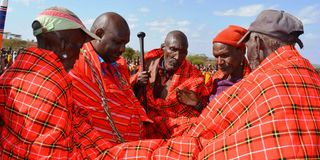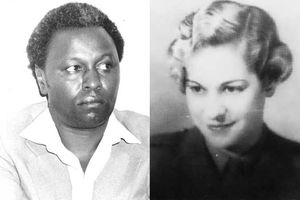Kenyans in shukas in north Uganda?

Elders dressed in shukas from the populous Purko clan in Narok County hand a traditional leadership black club to former governor Samuel Tunai. On a stop a few days ago in Lira, one of the northern Uganda boom towns, I saw three Kenyans in Maasai shukas walking about early in the evening, hawking their wares.
The average Kenyan and newspaper reader probably has never heard of Bududa town in eastern Uganda.
It is the administrative and commercial centre of the hilly Bududa District. A newish and beautiful road cuts through Bududa. At one point, you are confronted by a gigantic bright green-and-white sign that declares: “Nakuru 285Km. Nairobi 458Km. Mombasa 940Km.”
It is unusual to have such signage, showing only three distances to cities in a neighbouring country. On deeper reflection, it shouldn’t have been. The average Kenyan might have yet to hear of Bududa but is familiar with Lwakhakha, the Kenya-Uganda border town. In the 1970s and ’80s, it had a notorious reputation as a big smuggling town (or at least the statists who didn’t see the free cross-border as a virtue viewed it that way).
In the past four years, it has grown into a significant border crossing for the trucks ferrying goods from Kenya to South Sudan and the northwest Democratic Republic of Congo, and the towns along the route have also blossomed. Previously, the road to the border wasn’t worth being called a road; the Ugandan government splashed on the new highway and the game changed.
Trucks from South Sudan and northwest DRC returning to Kenya empty were required to use this route during the Covid lockdown. They complained that the Kenyan side was (and still is) crappy, nothing compared to the smooth drive across.
The signpost announcing how far away Nakuru, Nairobi and Mombasa is five kilometres from the border. You would think this truck traffic is why the sign is up inside Uganda. It is only part of the story, if at all. The fact is, after the Ugandan capital Kampala, Bududa town is the next largest daily destination for travellers from Nairobi. Three buses from Nairobi arrive daily in Bududa loaded with humans and go back full. Several Kenyan lorries come to Bududa, too and depart laden with produce.
Trade web
I asked about the buses. Somebody told me very many folks from the area work in Nairobi, Nakuru and Mombasa, so they and their relatives come and go daily. Bududa grows bananas (matooke), Arabica coffee and other food crops. I surmised that a trade web has developed among the thousands of Bududans who live and work in Kenya, Kenyans and Bududa. Else, people there get on with it, not bothered with why the trade and traffic boom exists.
Their reaction is understandable as it is a part of a broader complex geopolitical and regional economic rearrangement. If one adds the Port Bell-to-Kisumu Port link over Lake Victoria, Uganda has established three times more highways and major official links with Kenya than any of its other neighbours: DRC, Rwanda, South Sudan and Tanzania. And, bar Rwanda, its roads to the borders are superior to those of its neighbours leading to the same place.
Even a more scenic drive than Lwakhakha may be the soon-to-be-completed Kapchorwa-Suam Road, also in eastern Uganda, which links Kapchorwa, the district capital of the mountainous Kapchorwa District, to Suam, on the Kenyan border.
Lastly, the construction of the Soroti-Moroto road in Uganda was completed recently. Moroto, in Uganda, is the equivalent of Kenya’s Pokot or Turkana, populated by Karimojong, a cattle-loving and Kalashnikov-wielding herders. But the is to establish a platform for a new highway connecting Moroto to Lokitanyala, a border crossing from Uganda to Kenya’s town of Kitale.
Part of the explanation for this beehive of cross-border infrastructure is South Sudan, particularly the development of the Goli-Mahagi-Bunia Road, which connects the towns of Goli in Uganda with Mahagi, Djugu, Nizi and Bunia in DRC.
It’s feeding off two—indeed, three—developments. One is the rise of post-conflict northern Uganda, a boom driven by a bust of population growth, and the region’s emergence as the bread basket of independent South Sudan. Secondly, the slow emergence of DRC’s broad Orientale and North Kivu provinces, as they have grown fed up with the absence of the central government far away in the capital Kinshasa, and the unceasing conflict in the east.
Thirdly, the maturation of Kenya’s counties and the formation of the 14-county-member Lake Region Economic Bloc. LERB was formed in 2015 by counties mostly in western Kenya as an” economic bloc to enable the counties to leverage economies of scale and facilitate the development, management and utilisation of cross-boundary economic resources and infrastructure”. A large spillage of capital from these counties has altered fortunes in eastern and northern Uganda and South Sudan.
On a stop a few days ago in Lira, one of the northern Uganda boom towns, I saw three Kenyans in Maasai shukas walking about early in the evening, hawking their wares. Often, they are a sign that the money dam is about to burst. They are the harbingers of things to come.
Mr Onyango-Obbo is a journalist, writer and curator of the “Wall of Great Africans”. @cobbo3





